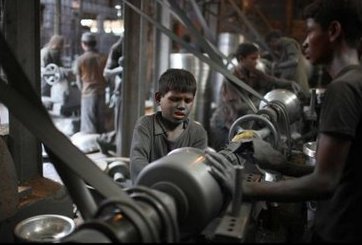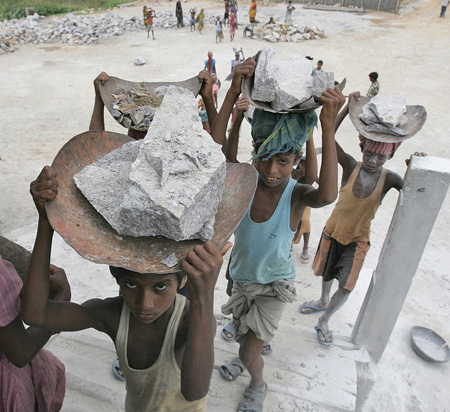Guest Blog by Sreeja in Mumbai:
Whether due to the fear of being boycotted by large US stores like WalMart, JC Penny or GAP, or whatever might be the compelling forces, the decision of the Indian apparel exporters to formulate a code to eliminate child labour from Rs 46,000 core garment export business is highly welcome.
 The issue of child labour has been a long lingering issue in the India and other developing and poor nations in the world and it should have been wiped out from the country as it cannot be part of a civilised and democratic society like ours. Though the government periodically takes some half-hearted measures, the issue has been there for all to see.
The issue of child labour has been a long lingering issue in the India and other developing and poor nations in the world and it should have been wiped out from the country as it cannot be part of a civilised and democratic society like ours. Though the government periodically takes some half-hearted measures, the issue has been there for all to see.
The immediate knee-jerk reaction for the Apparel Export Promotion Council (AEPC) in India to come up with a code to eliminate child labour is that the US government had last year included India in the Executive Order 13126 List (EOL) and Trafficking Victims Protection Reauthorisation (TVPRA) list of the US Labour Department, which relates to using child labour in its industries. The list is up for review again in September and the Indian apparel exporters are wary of being included in the list once again.
 A country is known to be using child labour, if it is included in the Executive Order 13126 List (EOL) and Trafficking Victims Protection Reauthorisation (TVPRA) list of the US Labour Department. Indian exporters face the threat of the US Labour Department branding India as a country that allows child labour in apparel making which will adversely affect the exports.
A country is known to be using child labour, if it is included in the Executive Order 13126 List (EOL) and Trafficking Victims Protection Reauthorisation (TVPRA) list of the US Labour Department. Indian exporters face the threat of the US Labour Department branding India as a country that allows child labour in apparel making which will adversely affect the exports.
Given the economic conditions prevailing in the euro zone, most Indian exporters are currently relying on a rebound in the US retail space for their orders in the coming season. The 27 EU members, along with the US, account for nearly 75 per cent of the overall apparel exports from India.
While a delegation, comprising government officials and members of the industry, recently met authorities in the US to present a case for exclusion of Indian garments from Executive Order 13126 list (EOL) and the government is striving hard to convince the US government that there is no incidence of forced child labour in the Indian garments industry, it is true that child labour exists in the country.
I think the government and the industry should come together in all its earnestness to nip this social evil from the bud. They should look at the issue from an emotional point of view. Everybody should understand that children should not be forced, for whatever reasons, to work at an age when they should be in the school.
Instead of engaging the ‘tiny tots’ in any work, they should be sent to school. It is in the interest of the country and its people too.
Kindly do it, now.






I read your article with interest and my first reaction is that everyone in the Government and the industry are guilty of knee-jerk responses. If the foreign buyers did not threaten boycott no one would do anything. That is a fact. The problem with this thinking is that the foreign buyers have taken an easy way out to appease their market. They put pressure on the Indian manufacturers who in turn put pressure on the Indian government, and the solution they find is to pass a law banning child labor.
Such laws have been passed in the past too but the implementation of the law is inadequate.
Secondly, banning child labor is no answer to the problem. Children are emplyed by the manufacturers because they come cheap and are not governed by unions, but more than that, children are required to work because their parents live in grinding poverty, and if every member does not bring in an income they would die of starvation.
Who is going to take responsibility for that? The problem of poverty is universal in third world countries. India may claim not to be a part of Third World now but as long as 500 million people live in poverty it cannot morally claim to have made progress.
I say that the problem of poverty eradication is as much the responsibility of the private sector as the public sector. I feel the foreigtn buyers and the Indian manufacturers must collaborate to give training and jobs to the parents of the children they exploit and together they should ensure financially and otherwise that the children of the poor people are given education enabling them to break the cycle of poverty.
Passing laws is not enough and will not solve the problem of poverty that dehumanizes so many people the world over. But all of us together can decide how to do this.
Love and good wishes — Arun